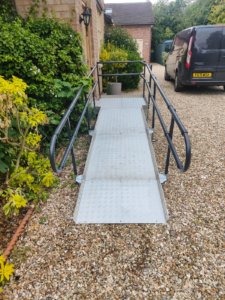
With the confusing plethora of guidance available over wheelchair ramp specifications at our fingertips, it can be hard to know what gradient ramp you will need. We’d like to make it easier for you, so we’ve broken it down into three key things to consider to help you arrive at the correct gradient for your application. These are:
A gradient of 1:15 is often required by social services and local authorities for public access situations, for example schools and libraries. More commonly however, a gradient of 1:12 is required for residential situations, and is also the minimum gradient required by building regulations for installed ramps. It’s worth remembering that building regulations only cover installed ramps, so for portable ramps the main considerations are what is safe, and what is sensible.
When it comes to space available, it might seem quite self-explanatory – just remember to consider every eventuality, for example will there still be enough space for a ramp at the front door when a vehicle is parked in the driveway?
If an installed ramp solution is required, space issues can often be overcome by using a platform to change the direction of the ramp by 90 degrees.
Where a portable ramp is required, a gradient of 1:8 is a very useful balance between gradient and space, and is suitable in most applications where there will be an assistant. For short threshold ramps even a 1:6 gradient can be acceptable – especially bearing in mind that the front wheels of the chair will be over the slope of the ramp before the back wheels reach it.
It’s really important to make sure that you choose the best gradient for the end user, to ensure that it will be as easy and safe as possible for them to get up and down the ramp. The main things to consider here are:
If the end user has a manual wheelchair and/or the ramp will be used for independent access without an assistant, it’s best to choose a shallower gradient for extra safety and ease of use.
If you take into account all three of the considerations above, you will be well set up for choosing the right gradient ramp for every client!
To find out more about how to make your wheelchair ramp assessments easier, take a look at part 1 and 2 of the ramp assessing blog series, and download your simple ramp assessment checklist! If you get a tricky application that you would like some assistance with, contact us and we’ll do our best to help!
Part 1: Wheelchair ramp assessing – what information do I need?
Part 2: Wheelchair ramp assessing – what’s best for the end user?